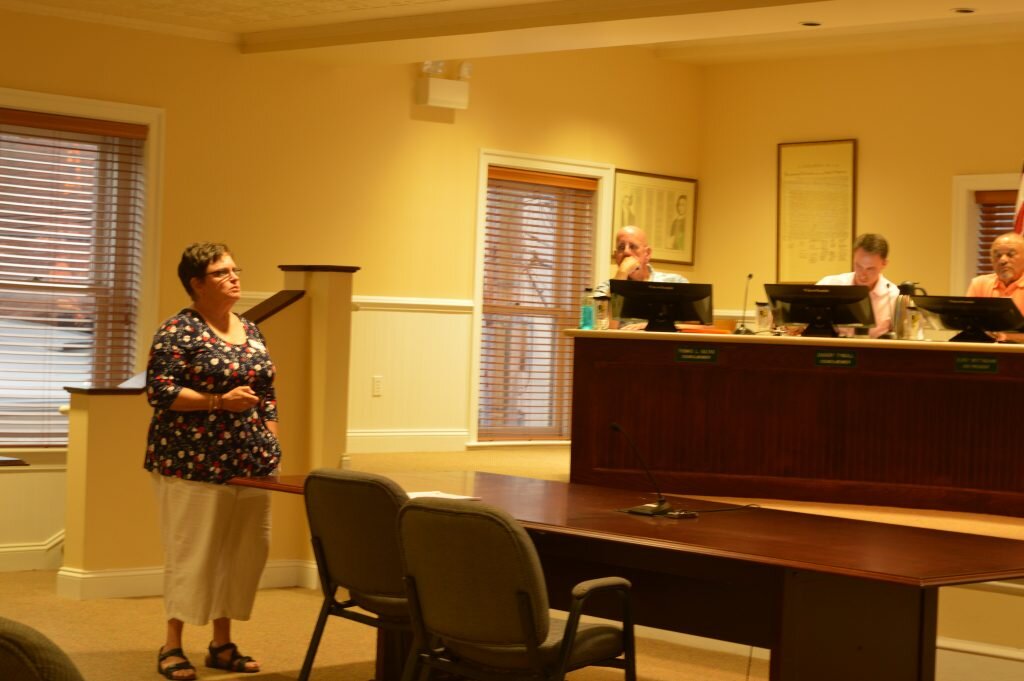
RACHEL RAVINA/BAYSIDE GAZETTE
Jean Holloway, state manager of Delaware and eastern Maryland for the Southeast Rural Community Assistance Project, provided an overview of her approach to restructuring rates during a Town Council meeting last Monday.
By Rachel Ravina, Staff Writer
(Sept. 5, 2019) Should the Town of Berlin decide to change restructure its water and sewer rates someday, the mayor and town council will have a good idea of how to begin, following a presentation last Monday by representative of an organization that helps small governments through the process.
Jean Holloway, state manager of Delaware and eastern Maryland for the Southeast Rural Community Assistance Project, provided an overview of her approach to restructuring rates.
“This is kind of a condensation of what I present for mayors and councils,” she said.
Berlin’s Town Administrator Laura Allen said Holloway was asked to share her approach with the public and the council she was recommended by Public Works Director Jamey Latchum.
Allen said she asked Latchum if he knew of anyone able to undertake a rate structure project, and he put her in touch with Holloway.
Holloway works for a nonprofit regional agency that receives financial assistance from several federal and state organizations, including the United States Department of Agricul- ture and the Environmental Protection Agency, so it can provide free services to communities of 10,000 residents or less.
Holloway’s first piece of advice was that any rate structure alteration had to be grounded on legality, efficiency, practicality, equity, and fairness.
“Revenues should not be used to pay for unrelated services (or visa versa),” she said.
She also said rates should be easy to understand and based on a well-planned budget.
Holloway also said it’s important to adjust rates because “the faster expenses rise, the sooner you start to lose.”
She illustrated this point through an analogy she called, “slicing the ‘pie.’” The pie demonstrated the “cost of operations” and the “source of cost recovery” through commercial industrial and residential factors.
“I can help to re-slice the pie, but I can’t change its size,” Holloway said.
Holloway also said transparency is key.
“[The] public should be informed of how rates are calculated,” she said.
Before increasing rates, Holloway said it’s crucial to “get a handle on unaccounted for water.” It’s a mathematical calculation that she said involves subtracting the total production from the total billed. Once that is determined, one would need to subtract the unaccounted for water from the known losses/system uses to get the non-revenue water.
Holloway said it should be less than 10 to 15 percent.
“If I can get a small town below 15 percent, I feel like I’ve done something,” she said.
Additionally, she said it’s important to reassess existing meters to weed out “any meters over 10 years old” that “are probably unregistered.”
Holloway clarified “under-registration means providing water you don’t get paid for.”
Holloway also said public works officials should be wary of “meters that only register in whole thousands [because that] can mean lost water, and that means lost revenue.”
Holloway also said it’s important to “get a handle on collections” and “make sure gallons in [a minimum] bill are optimal. This involves ensuring at least 95 percent of fees are collected and setting them “high enough to discourage repeat offenders.”
As for gallons, Holloway said they should they “should be high enough to protect low-end users” including senior citizens and single residents, but “know enough to avoid ‘giving away’ water that should be paid for by the usage unit.”
She also recommended no more than 3,000 gallons per month.
Holloway said there are three types of rates: a uniform or flat rate, which is the “same amount per period for everyone,” a metered minimum plus volume charge, which is a “minimum bill, with or without gallons included” and a block volume charge, which uses “different rates for different blocks or amounts used.”
Of those choices, Holloway tended to lean towards the second option.
“A consumer minimum plus volume rate is more equitable than [a] flat rate [because] customers pay only for what they use,” Holloway said.
After receiving data from town officials, Holloway said it would take roughly 40 hours to conduct the water study, and another 10 to 20 hours for the sewer study.
Assuming the council approves, Holloway is expected to begin surveying in October and provide recommendations by early 2020.
Once the study is complete, Holloway said she plans discuss her findings with a management team and determine if any revisions need to be made before bringing it to elected officials. She will present her findings to the public, as well as the mayor and council during an upcoming meeting.
